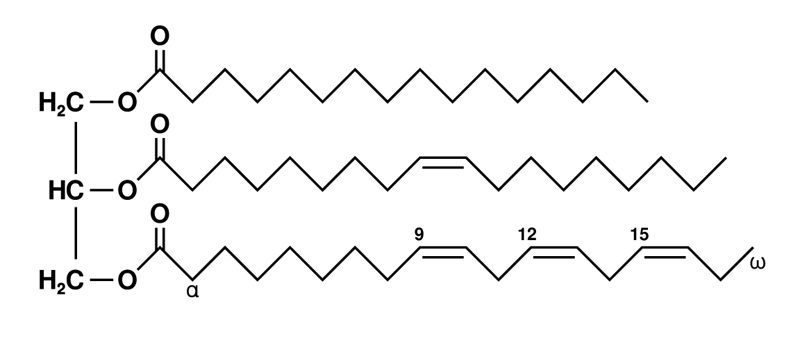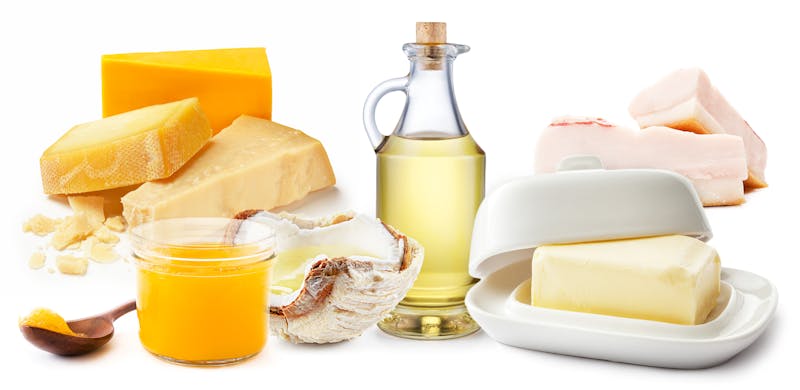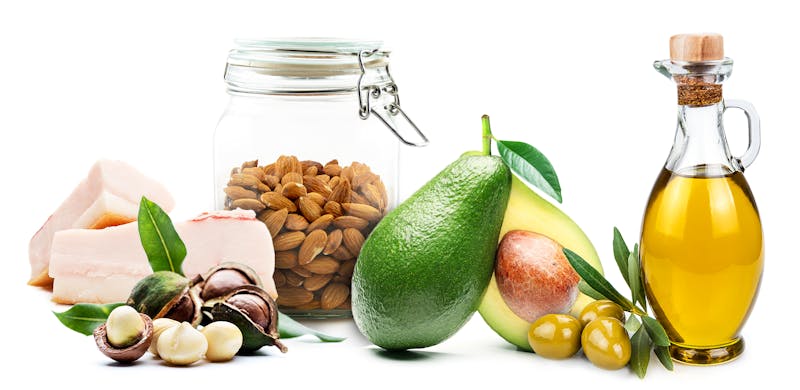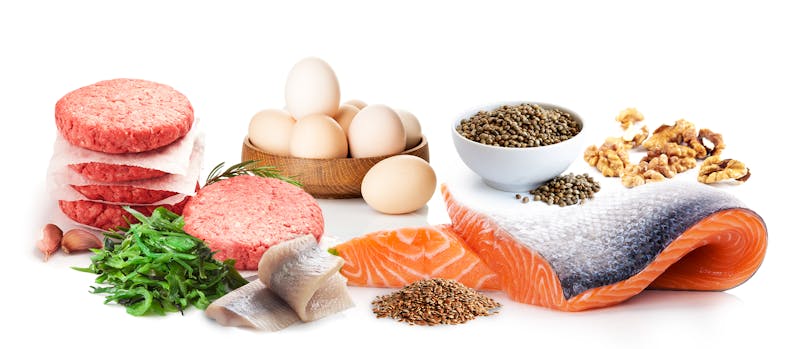What Type of Fat for Keto Diet
On a keto or low-carb diet, fat is your primary energy source, so choosing healthy types and eating the right amount is important. In this guide, we'll tell you all about fat and help you make the best choices.
- What is fat, and what roles does it play in the body?
- How are fats absorbed in the body?
- What is cholesterol?
- What types of fat should I eat?
- What types of fat should I avoid?
- How much fat should I eat?
What is fat, and what roles does it play in the body?
Dietary fat is found in both animals and plants. Although its main function is to provide your body with energy, it plays several other important roles, including:
- Helping you absorb the fat-soluble vitamins A, D, E, and K1
- Regulating inflammation and immunity2
- Maintaining the health of your cells, including skin and hair cells3
- Adding richness to food, which helps you feel full and satisfied4
The fat in food is in triglyceride form. Each triglyceride contains a glycerol molecule attached to 3 fatty acid chains that are made up of carbon and hydrogen atoms.

Example of an unsaturated fat triglyceride. Left part: glycerol; right part, from top to bottom: palmitic acid, oleic acid, alpha-linolenic acid.
The fatty acids are classified by the number of bonds they contain between the carbons in their chains, as well as the length of their chains.
Saturated vs. unsaturated fatty acids
-
- Saturated fats don't have any double bonds between the carbons in their chains. They are "saturated" with hydrogen and remain solid at room temperature. Healthy sources of saturated fats include butter, cream and ghee.
Saturated fatty acid myristic acid
-
- Monounsaturated fats have one double bond between carbons in their chains. Healthy sources of monounsaturated fats include olive oil, avocados and nuts.
Monounsaturated fat oleic acid
-
- Polyunsaturated fats have more than one double bond between carbons in their chains. Healthy sources of polyunsaturated fats include fatty fish, meat, nuts and seeds.

Polyunsaturated fat linoleic acid
There are two families of polyunsaturated fatty acids (PUFA's): omega-3 and omega-6 fatty acids. These are named for the position of the first double bond in their carbon chains.
Fatty acid chain length
- Short-chain fatty acids have 5 or fewer carbons. Short-chain fatty acids are present in small amounts in butter and cream.
- Medium-chain fatty acids (also known as medium-chain triglycerides or MCTs) have 6-12 carbons. Examples of foods that contain medium-chain fatty acids include coconut oil and MCT oil. Butter and cream also contain a small amount of MCTs.
- Long-chain fatty acids have 13 or more carbons. Most of the fats in food are made up of long-chain fatty acids. Examples of foods that contain long-chain fatty acids include meat, poultry, fish, dairy, nuts, seeds, avocado and olives.
You can read more about what fats to eat here.
How are fats absorbed in the body?
Once fatty foods have been digested, their triglycerides are broken down into individual fatty acids and glycerol.
Both saturated and unsaturated long-chain fatty acids are absorbed into the bloodstream, packaged with cholesterol and proteins, and transported throughout your system to be used or stored as body fat.
Short-chain and medium-chain fatty acids are absorbed differently. Instead of being transported throughout your body, they go directly to the liver, where they can be converted to ketones and used as a quick energy source.5 Additionally, they may be less likely to be stored as fat compared with long-chain fatty acids.6
What is cholesterol?
Cholesterol is a waxy substance found only in animal foods. Unlike fatty acids, it doesn't provide energy. However, your body needs it in order to produce steroid hormones, vitamin D, and bile acids that help digest fat.7
All of your cells make cholesterol. In fact, most of the cholesterol in your blood comes from your body rather than the food you eat.8 Dietary cholesterol usually doesn't raise blood cholesterol levels much, if at all, and therefore likely doesn't increase heart disease risk.9
What types of fat should I eat?
We recommend eating fats that occur naturally in food and have been minimally processed.
For several decades the American Heart Association and other health organizations have advised people to reduce their saturated fat intake.10 Unfortunately, that recommendation is based mostly on low-quality observational studies.
Yet most systematic reviews of randomized controlled trials — considered the strongest type of evidence — have failed to show a link between saturated fat and heart disease.11 Because of this, the role of natural saturated fats in a healthy diet is now being reconsidered.
Overall, saturated fat appears to be neutral for health.12 Learn more in our guide to saturated fat.
Saturated fat is found in a number of healthy foods that can – and probably should – be enjoyed on a well-balanced keto or low-carb diet.
What's more, no food contains 100% saturated, monounsaturated, or polyunsaturated fat. For example, red meat contains roughly equal amounts of monounsaturated and saturated fat, plus a small amount of polyunsaturated fat.
However, in some foods one type of fat is usually predominant. For example, butter is considered a good source of saturated fat, and olive oil is a good source of monounsaturated fat.
Below are several healthy sources of each type of fat.

Saturated fats
- Butter and ghee (clarified butter)
- Cream, whipping cream and coconut cream
- Coconut oil13
- Cheese
- Lard and tallow

Monounsaturated fats
- Olives and olive oil
- Avocados and avocado oil
- Macadamias and macadamia oil
- Almonds, pecans, peanuts, and other nuts
- Lard and tallow

Polyunsaturated fats
Omega-3
- Fatty fish (salmon, mackerel, herring, sardines, anchovies)
- Grass-fed animals
- Dairy from grass-fed animals
- Eggs from pastured chickens
- Algae
- Chia seeds
- Flaxseeds
- Hemp seeds
- Walnuts
Omega-6
- Found in almost every food, including meat, nuts and seeds.
- Vegetable and seed oils like safflower oil, sunflower oil, soybean oil and cottonseed oil – as well as processed foods that contain them – are often a major source of omega-6 PUFAs in modern Western diets.14 We recommend minimizing these oils because they are highly processed. However, the science on the health risks or benefits is inconclusive. You can learn more in our guide to vegetable oils.
Aim for a low omega-6:omega-3 PUFA ratio
The omega-6 PUFA linoleic acid and the omega-3 PUFA alpha-linolenic acid are considered essential fatty acids because your body needs them but can't make them on its own. Therefore, you must get them from food.
Alpha-linolenic acid is found mainly in seeds. However, the most important omega-3 fats are EPA and DHA, which are found in fatty fish and grass-fed meat. These long-chain fats are important for brain health and keeping inflammation under control.15 They may also reduce heart disease risk factors, although results from high-quality studies are mixed.16
Your body can convert alpha-linolenic acid to EPA and DHA, but in most people this conversion isn't very efficient.17
Achieving a balance of omega-3 and omega-6 fatty acids might also be important.
It's believed our evolutionary diet contained roughly equal amounts of omega-3 and omega-6 fats. However, due to heavy reliance on processed foods, many Western diets today may contain more than 15 times as much omega-6 as omega-3.18
Since at this time it's unclear how this dietary shift might be impacting our health, we feel it makes sense to mainly stick with the foods our ancestors consumed for thousands of years.
Having fatty fish at least twice a week, choosing meat and dairy products from grass-fed animals when possible, and eating less processed foods can help improve your omega-6:omega-3 ratio.19
The healthiest fats to cook with
Saturated fats such as butter, ghee, coconut oil and lard are the best options for frying and deep frying. These fats are resistant to heat and don't oxidize when reaching high temperatures, as the less stable polyunsaturated fats in vegetable and seed oils do.20
Some monounsaturated fats like olive oil are also good choices for high-heat cooking because they remain pretty stable when heated.21
It might be best to avoid using high-PUFA vegetable oils when cooking at very high temperatures. When heated, these fats are more likely to become oxidized, or damaged.22
Virgin (unrefined) avocado oil, which is high in monounsaturated fat, is also easily oxidized when exposed to high temperatures.23
At this time, evidence suggests that vegetable oils are probably fine for lower-heat cooking for short periods of time.24 But in order to minimize any risk, we recommend that you cook with butter, lard, or other heat-stable fats and use avocado oil to make salad dressing, mayonnaise, or other condiments that don't require heating.
More
For more about fats and sauces on a low-carb diet, have a look at our full visual guide:
What types of fat should I avoid or minimize?
We recommend completely avoiding trans fats (also known as partially hydrogenated oils) because of their adverse effects on heart disease risk factors.25
Fortunately, this has become easy to do, as they are banned in Europe and in the process of being eliminated from the US food supply by 2021.
The science is less clear on the health impact of processed vegetable and seed oils. These oils are highly processed and rich in polyunsaturated omega-6 fats, which most of us already get more of than we need.
High-oleic versions of safflower, sunflower, and other oils contain at least 70% monounsaturated fat and very little omega-6 PUFAs. This makes them more stable and less likely to become damaged when heated.26 On the other hand, they're still highly processed.
Even though there is currently no conclusive evidence that vegetable or seed oils are harmful to health, we recommend consuming natural fats like butter, olive oil, and coconut oil and minimizing the use of most highly processed vegetable oils.
How much fat should I eat?
On a low-carb or keto diet, most people don't need to count calories or fat grams. While keeping carbs low and protein within a fairly wide moderate range of 1.2-2.0 g/kg of reference body weight per day, most people can eat as much fat as they require to enjoy their meal. This approach often allows people to eat less, lose weight, and improve their health.27
If you still want to calculate fat grams, follow these general guidelines:
The amount of fat you should eat on a keto or low-carb diet depends on a number of things, including your protein and carb intake, your current weight, and your weight goals. Are you trying to lose, maintain, or gain weight?
Figure out your protein and carb needs first, and then fill in your remaining energy needs with fat.
You may have heard that on a keto diet, the more fat you eat, the more fat you will lose. This is likely not true. If you eat more fat than you need to enjoy your food or for energy supplies, this can slow down or stop weight loss, even if you eat very few carbs.28
This also applies to the medium-chain fats found in coconut oil and MCT oil, which are normally burned rather than stored. Your body is less likely to burn its own fat if it has excess dietary fat coming in, regardless of the type.
But although adding less fat at meals can help you burn more of your own body fat, don't make the mistake of trying to follow a diet that's low in both carbs and fat. This is a strategy that will ultimately leave you hungry.29 Eat enough fat to enjoy your food and provide the calories you need for your health progress.
/ Franziska Spritzler, RD
What Type of Fat for Keto Diet
Source: https://www.dietdoctor.com/low-carb/fat
0 Response to "What Type of Fat for Keto Diet"
Post a Comment